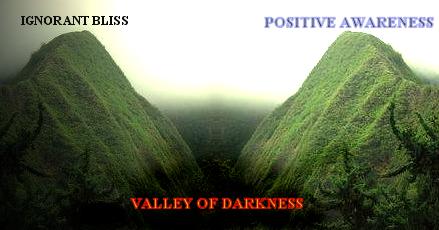http://www.anaditeaching.com/teachingintro4.htm
Whenever there is a progression towards light and truth, opposing forces and energies will naturally be present. In the dimension of forgetfulness, we are constantly being diverted as we move towards truth, pulled by forces of unconsciousness that would hamper or even jeopardize our awakening. A seeker should thus be aware of numerous pitfalls that may await him on the path.
Although they can indeed threaten our progress, these obstacles are not inherently negative, for moving through and beyond them is a natural part of the maturation of our intelligence and consciousness. There are countless types of pitfalls, but we can regard them as falling into three primary domains — understanding, practice and ego.

understanding in action
Sadly, the vast majority of seekers get spiritually stuck the moment they step onto the inner path. This is due to either their ignorance, or to the fact that they follow teachings that present a shallow vision of spirituality and enlightenment. They perform all sorts of practices in the name of self-realization, but get no closer to truth. True understanding is essential to avoid such stagnation. One has to enquire into the essence of spirituality as well as investigate the complex science of spiritual evolution as embodied in high teachings. Only in this way can a seeker discover the real purpose and significance of the path. True understanding of the inner dimension is a flowering of our intelligence and spiritual intuition, and reflects our maturity and sensitivity to the inner realm.
Spiritual practice is understanding in action based on the science of the inner states. At the heart of true practice lies insight into the nature of pure subjectivity — awakening to I am — the primary means through which a seeker cultivates the subtle art of becoming increasingly established in the realm of the self.
In order to experience real progress, one has to focus in a precise manner on the particular dimension of expansion that corresponds to one’s present level of evolutionary development. Unless we have a clear understanding of the state we are in, there is a danger that we will miss the intermediate steps of awakening necessary to bridge us with the far deeper levels of realization we are capable of reaching. If we try to move too quickly, our efforts will bear no fruit, for we cannot reach depths that we have no means to access. For instance, to aim at the dissolution of self or the actualization of oneness prior to first establishing the state of presence would be a misguided effort, for without a continuity of pure awareness, practices of surrender only result in even deeper unconsciousness. The inner work is progressive in nature; each phase of expansion must become stable and permanent so that it can serve as a solid foundation for the ensuing awakening.
The inner realm is such an unknown land, that without the proper conceptual tools and guidance, one is simply unable to navigate the process of expanding into and within it. The ability to correctly identify what is still incomplete in oneself, and to recognize the next step to be taken, reflects a well-refined attunement to the natural evolution of the soul towards her wholeness. In the absence of this inner clarity, one must receive support from a competent teacher.

errors in the verification of attainment
There are three common problems in the evaluation of one’s inner realization: first, one may mistakenly believe that one has arrived at an awakened state when none whatsoever has been reached; second, one may have arrived at an awakened state, yet due to a lack of sensitivity, be unable to register it; and third, having experienced a real awakening, one may not grasp its true nature and significance due to the fact that intelligence has not yet integrated with the newly awakened state. We find the first problem to be the most common.
Many seekers abandon the inner work altogether having arrived at only a superficial spiritual realization. This is especially true in the case of those who follow the simplistic paradigm of sudden awakening or believe that in order to reach enlightenment it is sufficient to have a purely intellectual insight into the nature of reality. Premature claims of enlightenment often lead to false spiritual confidence or even arrogance. To be caught in the delusion that one has reached enlightenment when one has not, only wastes the evolutionary energy one has already accumulated, and can easily block one’s further evolution.

attachment to conceptual understanding
Right understanding is a bridge between the plane of unconsciousness and the true reality. Superior concepts are not merely intellectual metaphors — they resonate with the energy of the truth they represent. Conceptual understanding of ideals such as ‘self’, ‘oneness’ or ‘enlightenment’ can even inspire us to initiate the spiritual search. Still, there is always a danger that by becoming overly attached to intellectual ideas we will find ourselves living in a virtual reality of mental constructs that actually separates us from reality as it is. Concepts are only representations of reality in the mind; reality itself is non-conceptual.
One can become convinced that ‘there is no self’ or ‘there is only the self’ and actually mentally experience existence as such, yet still not be established in any state beyond the mind, as ignorant to one’s true self as ever. This is the case of a false, intellectual ‘enlightenment’, in which one has been programmed to perceive reality in an ‘enlightened’ way through pseudo-sophisticated ideas and spiritual slogans.
True understanding is a direct and pure knowing of reality that reflects the soul’s blueprint and unique angle of perception. It is not a product of personal knowledge, ideas or philosophies, but an expression of the wisdom of universal intelligence seeing the truth of creation and evolution through the eyes of an awakened soul.

evolutionary imbalance
One of the most serious pitfalls on the path is an imbalance between one’s inner and outer evolution. Some misguided seekers suppress their psychological issues, fears and natural desires in the name of the quest for enlightenment. They see their outer reality as a threat to inner peace and stillness, and neglect their emotional development by spending too much time in meditation and solitude. If one becomes overly attached to the peace and calm of meditation, or spends excessive amounts of time alone, one tends to develop an unhealthy fear of the world, with its many challenges and distractions. The completion of the human personality requires that we engage in a well-balanced relationship with the world, for one can never be truly whole without psychological stability and emotional maturity.
In addition to becoming imbalanced in our relationship with the world and our human existence, we can also develop imbalances in our internal growth towards the self by becoming too extreme or one-sided in our practice. For instance, some over-crystallize awareness and neglect the expansion into being, while others deepen being but fail to address the work with awareness. Perhaps the most common imbalance we come across is a disproportionate development between the mind and heart. On one side, many on the path of love disregard the evolution of their intelligence and awareness and become trapped in emotional states devoid of clarity and inner stability; on the other, those who strictly follow the path of awareness and understanding tend to repress their sensitivity and, in consequence, remain alienated from their divine essence. To become integrated and whole, one has to follow the principle of harmonious evolution and possess a complete and holistic vision of oneself.

the snare of ego
Due to their simplistic nature, traditional models of enlightenment do not offer sufficient conceptual protection against the menace of ego. Because enlightenment is commonly misunderstood as occurring through the annihilation of the ego, it is assumed that after awakening, no challenges on the level of our ego-identity remain. However, even though the supreme goal of evolution is transcendence of the mind and personality, the ego cannot be entirely dropped before our final liberation. Rather, the ego, as the intelligence of our relative consciousness, naturally accompanies us through each stage of our growth, witnessing the awakening of the inner states, consciousness, intelligence and the heart. In actuality, its purified presence supports our internal awakening.
The nature of ego is twofold. The aspect of ego that surrenders to the soul’s intent is in fact the very energy that the soul uses for her evolution towards light. However, as long as the ego is lost in the past and holds on to its ignorance, it inevitably hinders our evolution by continuing to rule our consciousness as host. Most seekers, irrespective of their relative awakening, experience the ego, or false me, as their center of identity. They are egos, not yet souls. Prior to soul-realization, the ego claims awakening, believing that it owns the inner state and the knowledge of I am. As it matures in its evolution, it begins to recognize that it was originally created to serve our awakening, and that its final destiny is to surrender itself to the soul. However, until the ego has been sufficiently cleansed with the light of higher intelligence, it will resist its own dissolution. Even after realizing its own unreality, it will continue to return through the back door to assert supremacy. This is the point where one usually proclaims: “I am enlightened!”, “I am a master!”, “I have reached…”, “I… I… I…”
Until the mind surrenders, we remain vulnerable to the ego’s impure tendencies. In the initial stages of its inner quest, the ego’s immaturity leads it to treat spirituality as a playground for its basic emotions. It uses spiritual practice to wallow in feelings of self-pity, lack of self-worth, guilt and shame; or alternately, to inflate itself with pride, arrogance and competitiveness. The spiritual ego is in fact quite worldly. Entering the path has not changed its basic neurotic nature, only the sphere of its activities. Now, instead of wanting fame or fortune, it wants to reach god or attain enlightenment. In both cases we encounter the same bogus ego displaying its vanity.
In its madness, the ego constantly seeks ways to sneak into spiritual territory. It tries to make itself special in one way or another by taking on ‘spiritual’ roles — holy man, rebel, eccentric, even redeemer. The idea of being holy may appeal to the ego because it craves respect, if not from others, at least from itself. Or perhaps it is more attracted to rebelliousness and prefers the role of an unholy character, enjoying the chance to show off how original it is. Maybe it wishes to become a healer or great master, for it finds the idea of helping others exciting. It might even believe that it has a unique role to play on earth and has been chosen for great things. But perhaps the most insidious way that the ego can assert itself is by assuming a stance of humility and devotion to magnify a false sense of piety. No matter what role the ego chooses to play, its performances are no more than pitiful attempts to maintain its fundamentally empty identity.
The more conscious we become, the more cautious we must be, for the ego’s games become increasingly sophisticated as we evolve. Letting go of the ego is not only the final goal of the inner path, but an unremitting act of becoming real inside. As cunning as it is, the ego ultimately has no way to succeed in manipulating the spiritual path for its own purposes. Sooner or later it must relinquish itself at the altar of our original self, for it has no essential reality — it does not exist apart from the illusory image it projects.


